1. Current account in deficit in 2015, net international investment position positive
The current account deficit contracted to EUR 0.9 billion in 2015. The trade account strengthened notably, because the decline in goods imports was faster than the fall in goods exports. The deficit of the service account grew as service imports grew faster than service exports. During 2015, net capital inflow to Finland was EUR 2.0 billion. The net international investment position was EUR 1.3 billion positive at the end of the year. The data appear from Statistics Finland's statistics on balance of payments and international investment position.
1.1 Current account
The current account deficit contracted to EUR 0.9 billion in 2015. The trade account strengthened to EUR 1.9 billion, because the decline in goods imports was faster than the fall in goods exports.
The deficit of the service account grew to EUR 1.6 billion as service imports grew faster than service exports.
Figure 1. Current account balances, 2006–2015, EUR billion
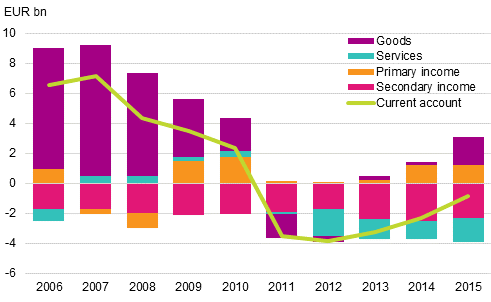
Of the other sub-items of the current account, the primary income account was EUR 1.2 billion in surplus, as in the year before. The secondary income account was EUR 2.3 billion in deficit.
Figure 2. Current account by sub-item, credits and debits, 2006–2015, EUR billion
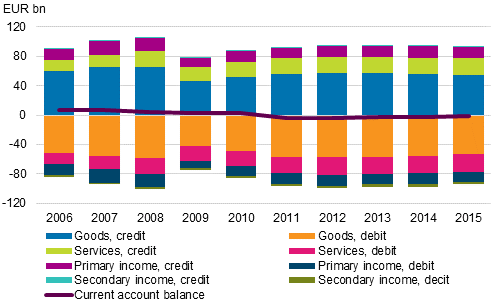
1.1.1 Goods trade
Over the year, goods imports went down by 5.7 per cent to EUR 52.8 billion and goods exports by 2.7 per cent to EUR 54.7 billion. From the top year of exports, 2008, the value of goods exports in balance of payments terms has fallen by 16 per cent and the value of goods imports in balance of payments terms by ten per cent.
Figure 3. Export and import of goods in balance of payments terms, 2006-2015, EUR billion
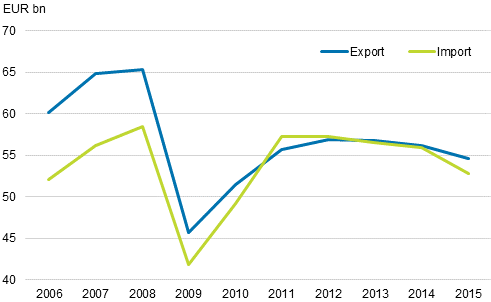
1.1.2 Services
The services account was EUR 1.6 billion in deficit as exports of services amounted to EUR 22.5 billion and imports to EUR 24.1 billion. The biggest single item in service exports was telecommunication, data processing and information services (ICT services), which accounted for nearly one-third of total exports of services. Other key items in service exports were other business services, transportation and travel. The most significant item in service imports was other business services.
Both service exports and service imports increased from 2014. The exports of services increased by 4.4 per cent and imports of services by 5.9 per cent. Of the sub-items of service exports, most growth was generated in ICT services and construction.
Figure 4. Items of service exports in 2015
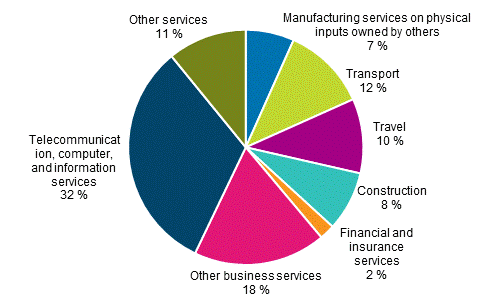
Travel receipts in 2015 amounted to EUR 2.3 billion and travel expenditure to EUR 4.3 billion, as a result of which the travel balance deficit was record high, EUR 2.0 billion. Travel receipts went down by 17 per cent year-on-year and travel expenditure grew by eight per cent. The decline in travel receipts was caused by the fallen consumption by Russian tourists in Finland. Travel expenditure to Spain, Estonia and Sweden went down from the year before.
Figure 5. Travel expenditure on travel from Finland abroad in 2010–2015, EUR million
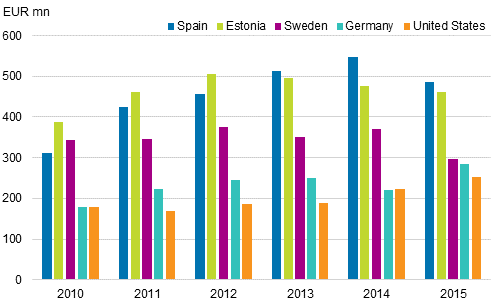
1.1.3 Exports by country
Goods and services combined, Sweden was still the biggest export country. In 2015, the value of the combined goods and service exports to Sweden was EUR 9.1 billion (goods exports EUR 6.0 billion and service exports EUR 3.1 billion). Other significant countries for goods and service exports were Germany, the United States, Russia and the United Kingdom. Total exports amounted to EUR 8.0 billion to Germany, EUR 5.9 billion to the United States, EUR 4.5 billion to Russia and EUR 4.3 billion to the United Kingdom.
The combined exports of goods and services to Sweden went down by 3.4 per cent. Exports to Germany rose by 7.4 per cent and exports to the United States by 4.0 per cent from the year before. The United States became the third biggest export country after Germany.
Figure 6. Goods and services, export by country 2015, EUR billion
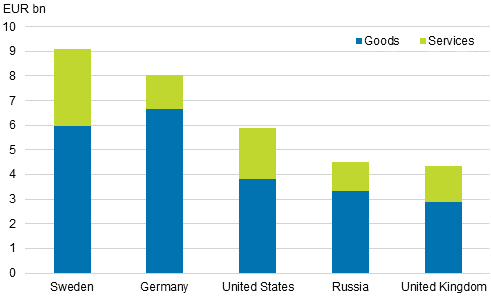
The export of goods and services to Russia went down by 29,3 per cent and import of goods and services from Russia went down by 28.6 per cent from the previous year. The deficit of Russian trade declined to EUR 1.7 billion, while one year before it was EUR 2.4 billion. From 2012, exports to Russia have fallen by 42.6 per cent and imports from Russia by 42.5 per cent.
Figure 7. The combined trade of goods and services with Russia, 2006-2015, EUR billion.
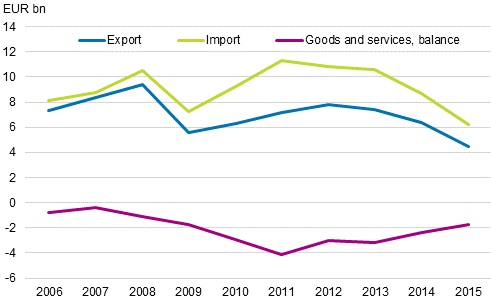
1.1.4 Primary income and secondary income
Primary income flows to Finland amounted to EUR 14.7 billion and primary income paid to non-residents to EUR 13.5 billion in 2015. The primary income account was EUR 1.2 billion in surplus. The surplus of the primary income was on level with the previous year.
The primary income account consists of compensations of employees, investment income and other primary income. The most significant item of these was investment income, of which EUR 0.7 billion in net were paid to Finland. In 2015, investment income to Finland amounted to EUR 13.2 billion. Investment income paid abroad from Finland amounted to EUR 12.5 billion.
The secondary income account was EUR 2.3 billion in deficit (EUR -2.5 billion in 2014). In the secondary income account, EUR 1.1 billion were paid to Finland and EUR 3.4 billion from Finland.
1.2 Financial account and international investment position
During 2015, net capital inflow to Finland was EUR 2.0 billion, that is, the investment flow from abroad to Finland was greater than investments from Finland to abroad. Finland's net international investment position was EUR 1.3 billion at the end of 2015, having been EUR -5.4 billion one year earlier. The net international investment position describes the difference between foreign assets and liabilities.
Net debt in 2014 turned into net assets during 2015 and at the same time, the fall in the net investment position that started in 2010 ended. At the end of 2015, Finland had EUR 701.8 billion in foreign assets and EUR 700.5 billion in foreign liabilities. Changes in prices increased Finland's net investment position by EUR 5.0 billion in the course of 2015.
Figure 8. Financial account 2006-2015, EUR billion
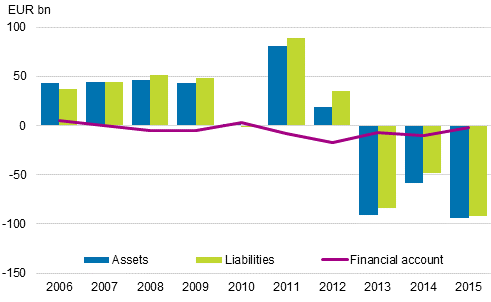
1.2.1 Financial account and international investment position by sector
The other monetary financial institutions sector had the most foreign assets and liabilities at the end of 2015. At the end of the year, other monetary financial institutions, such as banks and other credit institutions, had EUR 242.0 billion in foreign assets and EUR 322.2 in liabilities. The sector's net liabilities mainly increased due to the decline in securities-based assets, but also on account of liabilities related to direct investments. In turn, the decrease in cash and deposit assets diminished net liabilities.
The central bank's net assets remained at the previous year's level, at EUR 34.4 billion. The central bank's reserve assets grew slightly, but assets from portfolio investments and other investments declined.
Figure 9. Net international investment position by sector 2006–2015, EUR billion
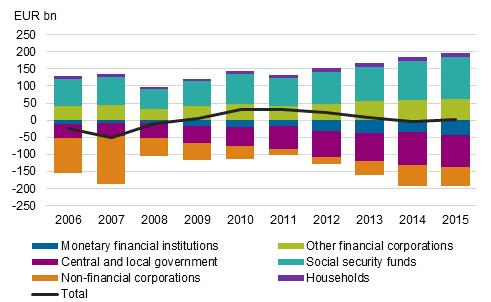
Non-financial corporations' foreign assets made an upturn and liabilities also continued growing. Non-financial corporations' foreign net liabilities contracted during the year, amounting to EUR 57.3 billion at the end of the year. Non-financial corporations had EUR 136.2 billion in foreign assets and EUR 193.5 billion in liabilities at the end of the year. The growth in assets related to cash assets and deposits had the biggest impact on the non-financial corporation sector's net liabilities.
Social security funds' net international investment position continued to grow during 2015. At the end of the year it stood at EUR 122.1 billion. The net growth in the sector was EUR 6.3 billion, while at the end of 2014 the net investment position was EUR 115.8 billion. Social security funds increased their investments in shares and mutual fund shares.
1.2.2 Finland's outward portfolio investments
The net flow of outward investments directed to foreign securities, that is, the difference between purchases and sales totalled EUR -0.6 billion in 2015. Investments in foreign shares decreased by EUR 1.3 billion, while in 2014, share ownership grew by EUR 1.7 billion. Shares in mutual funds registered abroad were purchased to the value of EUR 2.6 billion, which was slightly more than in the year before. Investments in long-term bonds decreased by EUR 2.6 billion in 2015, which was a significant change of direction compared with the previous year, when they grew by EUR 8.5 billion.
Mutual funds registered in Finland had the highest capital outflow and their investments in foreign securities grew by EUR 3.3 billion, which was slightly less than in the year before. Insurance corporations boosted their foreign portfolio investments by EUR 2.7 billion, most of which consisted of investments in bonds. Monetary financial institutions (excluding the central bank) in turn decreased their investments in foreign securities by EUR 9.5 billion in 2015, while in the year before, investments grew by EUR 7.6 billion. This was mainly caused by repatriation of investments made to bonds.
Figure 10. Stocks of outward portfolio investments in 2015 by investor sector, EUR billion
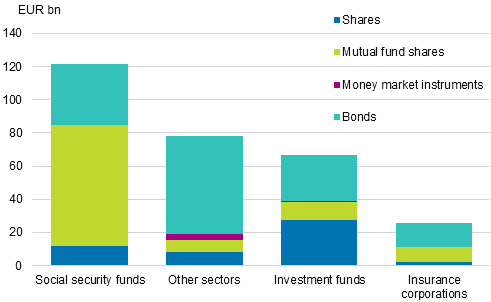
The market value of Finland's outward portfolio investments was EUR 291.9 billion at the end of 2015. Price changes decreased the market value of portfolio investments by EUR 0.5 billion over the year, while as a result of exchange rate changes, the market value grew by EUR 7.9 billion. Correspondingly, portfolio investments grew by EUR 11.5 billion in the previous year because of price changes and by EUR 6.8 billion due to exchange rate changes. Price changes raised the value of shares and mutual fund shares by 1.4 per cent.
Figure 11. Annual change of outward portfolio investments 2006–2015, EUR billion
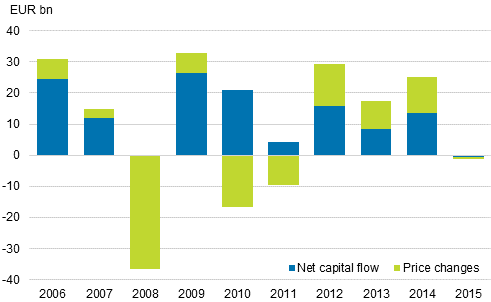
Altogether, EUR 6.0 billion were paid as profits related to outward portfolio investments. Dividend income from abroad to Finland amounted to EUR 2.7 billion, while one year before, the corresponding figure was EUR 2.4 billion. Interest income paid from abroad to Finland was slightly less than the year before, that is, EUR 3.3 billion.
1.2.3 Inward portfolio investments
Portfolio investment liabilities grew in total by EUR 6.4 billion in 2015. EUR 2.2 billion of this are explained by foreign investors' new investments in Finnish securities and the rest, EUR 4.2 billion, by the rise in the value of securities. Compared with 2014, the investment flow to Finland contracted distinctly.
Non-financial corporations' portfolio investment liabilities grew in total by EUR 2.0 billion from EUR 77.3 billion to EUR 79.4 billion. Foreign investors used EUR 0.4 billion to purchase Finnish non-financial corporations' shares, while one year before, EUR 4.6 billion in net were invested in the shares of Finnish non-financial corporations from abroad. During 2015, the value of Finnish non-financial corporations' shares also grew, which increased the investment stock. Price changes increased the share liabilities of non-financial corporations by 7.9 per cent compared to the stock of investments at the end of 2014, while, at the same time, the comparison index (OMX Helsinki CAP) rose by 11.7 per cent. Foreign investors increased their investments in bonds issued by non-financial corporations by EUR 0.5 billion, while one year earlier, investments decreased by EUR 4.1 billion.
Figure 12. Finnish non-financial corporations' portfolio investment liabilities, investment flows 2006–2015, EUR billion
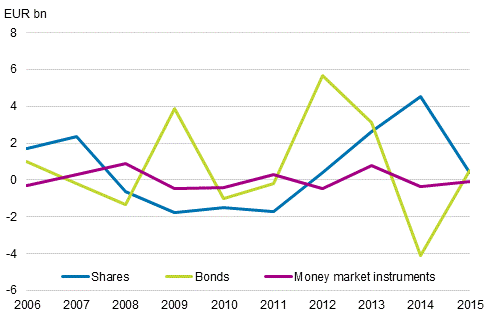
The majority of non-financial corporations' portfolio investment liabilities, over 83 per cent, was foreigners' investments in shares. Foreign investments directed to non-financial corporations' bonds made up under 16 per cent of the portfolio investment liabilities.
Figure 13. Finnish non-financial corporations' portfolio investment liabilities, investment stocks 2006–2015, EUR billion
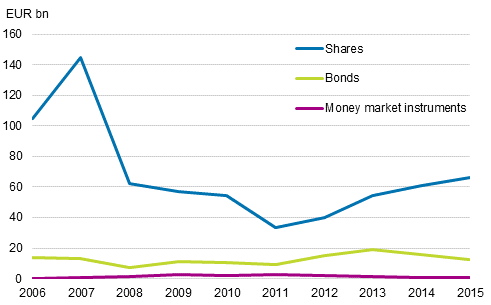
In 2015, dividends paid to foreign investors on portfolio investments in Finland totalled EUR 3.4 billion, while one year before, dividends paid to foreign investors were EUR 0.1 billion lower. Only slightly less interests were paid abroad from Finland than in the previous year, that is, EUR 4.5 billion.
1.2.4 Direct investments
In this publication, foreign direct investments are examined in gross amounts. This means that intra-group foreign liabilities and assets included in direct investments are not netted in any respect. Data for 2015 on direct investments according to the directional principle will be published on 27 October 2016.
At the end of 2015, gross direct investment assets stood at EUR 132.5 billion and corresponding liabilities at EUR 121.3 billion. Assets went up by EUR 5.4 billion and liabilities by EUR 14.5 billion. In assets, both equity and debt-based items grew, while the increase on the liabilities side is explained by a strong growth in intra-group debts.
Examined in gross, the fall in direct investment assets in 2013 to 2014 halted and assets have continued growing in the early part of 2016 as well. In turn, liabilities grew to the highest level in history at the end of 2015. As a result of the stronger growth in liabilities than in assets, net assets connected to direct investments nearly halved in 2015 to EUR 11.2 billion compared to EUR 20.3 billion in the year before.
Figure 14. Direct investment assets and liabilities on gross 2006–2015, EUR billion
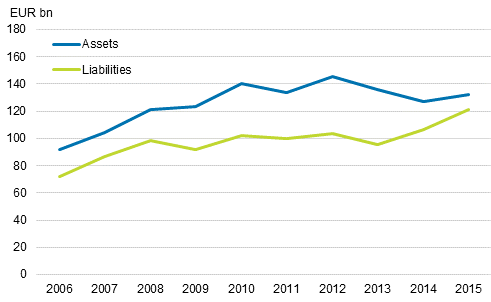
In 2015, Finland's returns on FDI assets amounted to EUR 7.0 billion, which is EUR 1.6 billion less than in the previous year. EUR 4.0 billion were recorded as returns of foreign owners on FDI liabilities, which is also clearly less than a year earlier (2014: EUR 5.1 billion). Relative to the gross assets and liabilities at the end of 2015, the returns on assets invested abroad from Finland were 5.3 per cent and of outward FDI 3.3 per cent, while the corresponding figures were 6.7 and 4.8 per cent in 2014.
Figure 15. Profits received and paid on direct investments 2006–2015, EUR billion
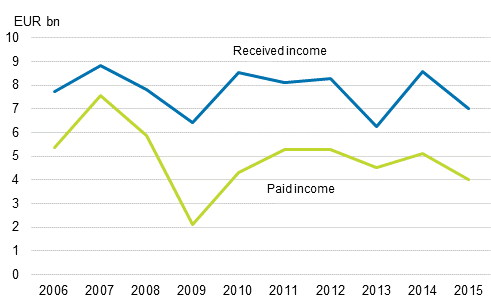
Direct investments were held primarily by the non-financial corporations and financial corporations sectors. The sector is determined based on the sector of the domestic party of the investment relationship. The non-financial corporations sector accounted for 79 per cent of FDI liabilities and the financial sector for 20 per cent. The non-financial corporations sector held the share of 87 per cent and the financial sector 11 per cent of FDI assets.
Figure 16. Direct investment assets on gross in 2015, (shares by sector)
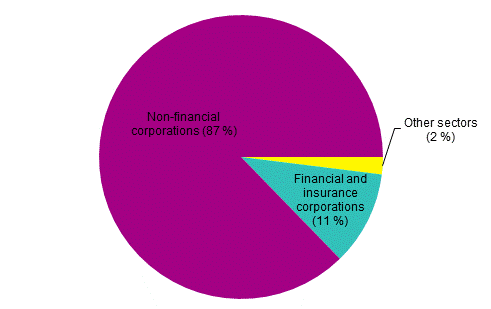
1.2.5 Derivatives and other investments
At the end of 2015, Finland had EUR 100.3 billion in assets related to derivatives and EUR 97.1 billion in liabilities. Most of the assets and liabilities related to derivatives were held by banks. From the end of 2014, derivative assets decreased by EUR 24.5 billion and liabilities by EUR 20.7 billion.
Other investments in the financial account include loans, deposits, trade credits and other equity. Other equity consists of equity that is not in the form of securities and that comprises holdings in international organisations, branches and other units without a separate legal identity. In other investments, Finland's assets were EUR 167.8 billion and liabilities EUR 184.0 billion at the end of 2015, most of which were held by the central bank, other banks and non-financial corporations.
The biggest change in other investments took place in cash assets and deposits, where liabilities went down from EUR 154.6 billion to EUR 137.3 billion.
Finland had EUR 82.8 billion in deposit assets and EUR 137.3 billion in liabilities at the end of 2015. Loan assets amounted to EUR 60.6 billion and liabilities to EUR 24.0 billion.
Source: Balance of payments and international investment position, Statistics Finland
Inquiries: Tapio Kuusisto 029 551 3318, Saana Ranta-Ruona 029 551 3375, balanceofpayments@stat.fi.
Director in charge: Ville Vertanen
Updated 30.9.2016
Official Statistics of Finland (OSF):
Balance of payments and international investment position [e-publication].
ISSN=2342-348X. 2015,
1. Current account in deficit in 2015, net international investment position positive
. Helsinki: Statistics Finland [referred: 15.1.2026].
Access method: http://stat.fi/til/mata/2015/mata_2015_2016-09-30_kat_001_en.html

